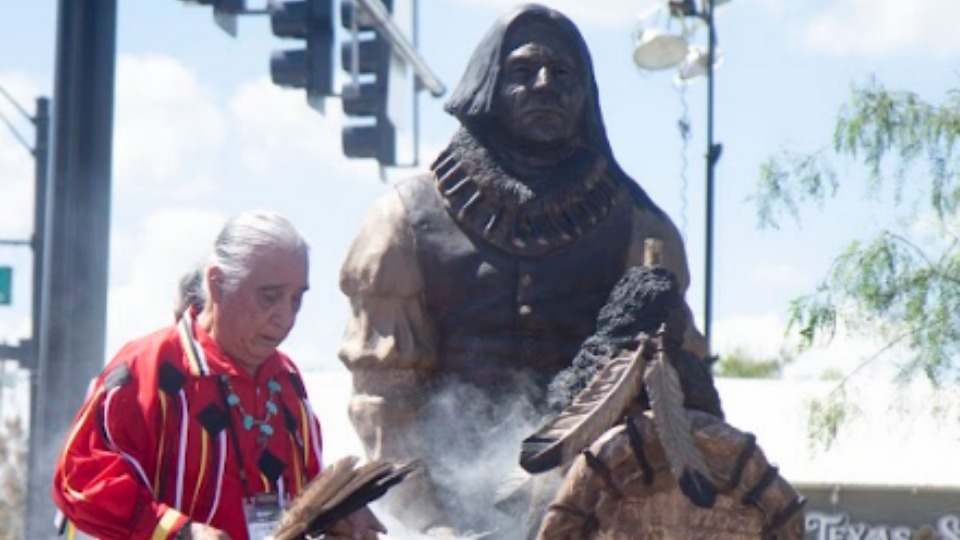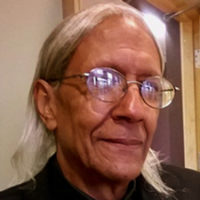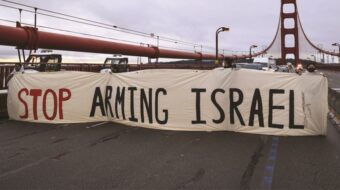
GRAPEVINE, Texas—On Sep. 29, 1843, there took place the historic Treaty of Bird’s Fort at the Grapevine Prairie between Native Americans and Republic of Texas President Sam Houston. In commemoration of this peacemaking event, a “Peace Circle” public art event was held in Grapevine, Texas on Saturday, Sept. 18, 2021, which was observed by Indigenous Americans and the city residents. The commemoration was held on Peace Plaza at Grapevine Main Station, where a tipi was also erected.
Sam Houston was considered Indian-friendly by many Native people, having spent his younger years with the Cherokee people in Tennessee. Houston and the Native leaders met in a time of conflict, but they were determined to go forward in a spirit of peace, friendship, trust, and most of all with a feeling of hope for a future without the grim specter of relentless war.
The chiefs, captains, and Houston met to pool their efforts to find a place where the tribal nations could live in peace and harmony. The Peace Circle meeting led to the signing of the Treaty of Bird’s Fort on Sept. 29, 1843.
Fast forward to the present, and many of the tribal representatives in attendance for the 2021 Peace Circle were, in fact, descendants of the chiefs and captains who signed the historic treaty. Twenty-one Indigenous nations were represented at the commemorative gathering on Saturday.
To properly mark the event, statues of the ten chiefs and captains who were signatories to the treaty were unveiled at the Peace Circle. There was also, of course, a statue of Sam Houston.
The statues were created by Grapevine artist-in-residence Linda Lewis, and the features of the leaders and the tribal clothing of that time period were thoroughly researched to ensure accuracy. Each leader’s physical attributes and the smallest details of historic clothing were garnered from consulting tribal members, pouring over photographs and paintings, and working with relatives to confirm that the representations were accurate to each tribal nation. These representations were approved by the Native nations they represent.

Profiles of the signing chiefs and captains
The leaders represented in the Peace Circle are listed in the order in which they signed the Treaty and stood in counterclockwise positions in a circle honoring traditional lifeways. Biographical information on each chief and captain was provided by tribal historians as follows:
Roasting Ear, Pacondalinquaing, (tribal name), Delaware Chief—the renowned patriarch of the Delaware people in Texas. He was a diplomat, councilor, and orator, and the first to sign the Treaty. He died in February 1845.
Ishtaytakaat Abi, Chickasaw Captain—had the reputation of honor, courage, strength, selflessness, and the ability to defeat his enemies. His goal in 1843 was to secure peace for Indian people.
Ahcaquash, Waco Chief—renowned as a great negotiator. He was known as a mediator not just for his own nation but for other nations as well in dealing with the Republic of Texas.
Kechikaroqua, Tawakoni Chief—the oldest of the Peace Circle Chiefs and a respected elder. He was the principal chief of the Tawakoni Nation.
Red Bear, Caddo Chief—an articulate and wise leader who said, “I do not like to see guns firing and blood spilled, for I am a friend of peace.” He expressed a longing for peace.
Jose Maria, Iesh (tribal name) Anadarko Chief—a valiant principal chief who fought many battles against the white settlers. He is described by his descendants: “Few had equaled and none had surpassed his bravery, his nobility, and his good sense whether in battle, in council, or in the presence of presidents. His heritage to us is of the highest order.”
Towaash, Ioni Chief—a steadfast leader who expressed his desire for peace with the following words: “Now I can go home to my people and tell them that all is good, that they can eat and sleep in safety and feel no more afraid.”
Hoyo Tubby, Biloxi Chief—met with Sam Houston on the Grape Vine Prairie in the preliminary conference in August of 1843 and in September signed the Treaty with the other chiefs and captains.
Chicken Trotter, Cherokee Captain—the last of the leaders and the youngest to sign the Treaty. Chicken Trotter, whose Anglo name was Devereaux Bell, was also a leader of the Cherokees who retreated to Monclova, Coahuila, Mexico after the Battle of the Neches in the Cherokee War of 1839 and continued the war against Texas. He was considered a natural leader, fearless, and an independent thinker.
Background of the Treaty of Bird’s Fort
The Treaty of Bird’s Fort was the result of years of conflict and bloodshed between Native American nations and the onrushing tide of white settlers who later called themselves Texans. The Kiowa and Comanche, and others who were the original nations of present-day Texas, had no choice but to resist the invasion of Euro-American colonists.
The political situation was further complicated by the claims of Mexico in Texas over lands that had been the homes of Indigenous sovereign nations since time immemorial. Further complications were the claims of the Native peoples from east of the Mississippi who had been driven west by the relentless white tide. Cherokees had settled in Texas in the early 1800s in tandem with or later followed by Shawnees, Delawares, Kickapoos, Chickasaws, Choctaws, and others.
Paramount in this tribal cavalcade were the Cherokees, who were considered to be the leading tribal entity in this confederation of displaced eastern Indigenous peoples. The Treaty of Bowles Village was signed in 1836 in Sam Houston’s first tenure as Texas president. He was succeeded by Mirabeau Lamar, who seemed to have a pathological hatred of all Indians, particularly Cherokees. His violation of that Treaty led directly to the Cherokee War of 1839.
Ironically, most of the whites encroaching on Indian lands were from the very same Southern states that were responsible for the genocidal Trails of Tears. Lamar was from Georgia and had spent his formative years growing up silhouetted by the hideous shadow of that state’s exterminatory expulsion of the Cherokee Nation. This was a state bent on the destruction of all Indians within its grasp.
Lamar was succeeded by Houston, who, because of his background and humanity, pursued a policy of peace in lieu of a war that was exacting a heavy toll largely exhausting Native Americans, Euro-Americans, and Tejanos.
The Treaty’s significance marked in the present
While the Treaty can be subject to criticism from the unforgiving prism of history in some respects, it did provide a respite from the sanguinary war being waged by the settler invasion.
But, again fast forwarding to the present, while classified as a public art event for the city of Grapevine, the Peace Circle was more than just a public art excursion; it was an event of paramount contemporary significance.
The Peace Circle is an interpretation of a moment in history chronicling a meeting of the Sam Houston and ten Indigenous leaders, chiefs, and captains on the Grapevine Prairie in August of 1843. This set the stage for the signing of the Treaty of Bird’s Fort on Sept. 29 of the same year.
The Treaty did bring a measure of peace. In the words of J.C. Thompson, Cherokee, and a former chairman of the Mount Tabor Indian Community of Texas, the Treaty brought “a peace that had to be fought for with the blood of Native Americans, Euro-Americans, and Tejanos. This treaty that we are here celebrating was the beginning of a new day for Texas and because of the recognition given to the tribes to have a right to remain in the Republic of Texas, wherein the Mount Tabor Indian Community was formed.”

The public art depicting the Peace Circle consisted of the 11 bronze statues, larger than life, eight feet tall, depicting leaders from the Delaware, Chickasaw, Waco, Tawakoni, Keechi, Caddo, Anadarko, Ioni, Biloxi, and Cherokee tribal nations and Sam Houston. The Peace Circle meeting fostered the signing of the Treaty of Bird’s Fort. This treaty was one of the few ratified by the Texas Senate.
The Peace Circle commemorative event began with a dedication ceremony comprised of the representatives of the tribal nations involved in the Bird’s Fort Treaty, the Sam Houston Memorial Museum, and the Peace Circle Advisory Committee.
The dedication ceremony began with a Land Acknowledgment by Mayor Pro Tem Darlene Freed which stated that the City of Grapevine respectfully acknowledges all Native people who have lived on the Grape Vine Prairie since time out of mind and reasserting its friendship and connection to the ten nations who met with Houston in 1843.
There was a ceremonial unveiling of each statue by representatives of each tribe along with family members of each honored leader. Many family descendants of the leaders depicted by the statues were actually moved to tears.
The ceremony also included the “Wyandotte Thanksgiving Address,” shared by Sallie Cotter Andrews of the Wyandotte Nation. This was delivered in Wyandot and English. This writer deemed it appropriate to cite a few beautiful excerpts in English as follows:
Now listen up everyone!
Now it happens we are of one mind
We have gathered together
We give thanks to our Mother of the earth
We give many thanks for our fresh waters
We give thanks for the grasses and the bushes
We give many thanks for all the medicines
We give many thanks for all the trees
We give many thanks for all the foods
We give many thanks for all the animals
This was followed by a blessing from Eddie Sandoval, Apache, and Leslie Thunderhawk, of the Rosebud Sioux Nation. Tribal flags were presented accompanied by the Comanche flag song.
Grapevine Mayor William Tate spoke on the history of the prairie area and its people and was instrumental in making the commemoration a reality.
Also, Peace Medals were presented to representatives of each Indian nation present, symbolizing that the City of Grapevine reasserts its commitment to the peace and friendship promised by Houston in 1843. Each medal included a replication of the original 19th century presidential peace medals depicting a handshake, a peace pipe, and tomahawk.
The ceremony closed with a Comanche drum followed by a friendship dance. (Ironically, even as the Peace Circle was concluding, this writer received email information that the State of Texas, by way of its attorney general, was in the forefront of a national campaign declaring war on Native children by attacking the Indian Child Welfare Act).
The other activities after the conclusion of the ceremony included educational booths and symposiums at the Peace Plaza conducted by the Indigenous Institute of the Americas. It is hoped that the follow up to the Peace Circle Commemoration will be support for Native communities working to heal and move forward.












Comments